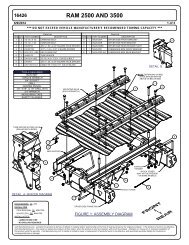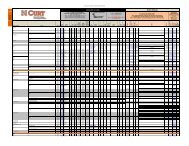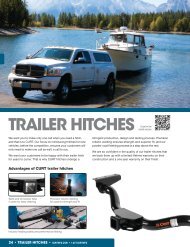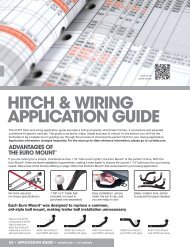UNDERSTANDING TOWING - CURT Manufacturing
UNDERSTANDING TOWING - CURT Manufacturing
UNDERSTANDING TOWING - CURT Manufacturing
Create successful ePaper yourself
Turn your PDF publications into a flip-book with our unique Google optimized e-Paper software.
Weight Distributing Capacity (WD)<br />
The measure of the total weight a trailer hitch can safely pull<br />
with a weight distribution system installed. The use of a weight<br />
distribution system balances the weight of the cargo throughout<br />
the trailer, allowing for better steering, braking and level towing.<br />
See page 193 for our weight distribution products.<br />
Sway Control<br />
Trailer Hitch<br />
A: Ball diameter<br />
B: Shank length<br />
C: Shank diameter<br />
D: Rise<br />
Without weight distribution<br />
With weight distribution<br />
A device used to reduce the lateral movements of trailers which<br />
are caused by the wind. These may be used with or without a<br />
weight distribution system. Do not use this on a trailer hitch with<br />
an 1 1/4" x 1 1/4" receiver tube opening or on trailers with surge<br />
brakes. See page 196 for our sway control products.<br />
Trailer Balls<br />
Sway Control<br />
Wt. Distribution<br />
Trailer<br />
The object that connects the trailer hitch and the trailer.<br />
There are many factors that determine the correct trailer ball:<br />
• Most important is the trailer ball's gross trailer weight rating<br />
• The hole diameter must not be more than 1/16"<br />
larger than the threaded shank<br />
Every time you tow, check the nut and lock<br />
washer to make sure they are fastened securely.<br />
Note: The mounting platform must be at least 3/8" thick.<br />
See page 212 for our complete trailer ball line.<br />
Tongue Weight (TW)<br />
The downward force that is exerted on the trailer ball by the<br />
coupler. The tongue weight will vary depending on where<br />
the load is positioned in relationship to the trailer axle(s).<br />
To measure the tongue weight, use either a commercial<br />
scale or a bathroom scale with the coupler at towing height.<br />
When using a bathroom scale, use the method shown and<br />
multiply the bathroom scale reading by three.<br />
2' 1'<br />
Pipes<br />
To Trailer<br />
Bathroom Scale Brick<br />
Safety Chains<br />
Safety chains are required by law and should be crossed<br />
under the tongue of the trailer so that the tongue will not drop<br />
to the road if it becomes separated from the hitch. Always<br />
leave enough slack so the vehicle can safely turn. Never allow<br />
the safety chains to drag on the ground and never attach the<br />
chains to the bumper. <strong>CURT</strong> offers chains in a variety of<br />
capacities to meet your towing needs.<br />
Each safety chain or safety cable must equal or exceed the<br />
gross trailer weight rating of the trailer. See page 211 for<br />
custom chain, or page 210 for standard packaged safety chain.<br />
Proper safety chain routing<br />
crosses under the coupler<br />
curtmfg.com • 1.877.curtmfg • <strong>UNDERSTANDING</strong> <strong>TOWING</strong> • 7










